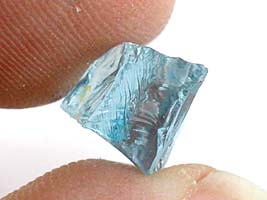Gem Rough Orientation: Looking Beyond the Obvious Cut
Gem rough orientation isn't always simple. Sometimes the obvious cut may not be the best choice. Learn how orienting rough can affect gem yields and prices.
1 Minute Read
For example, take a look at the piece of aquamarine in the picture below. At first glance, this rough looks like an obvious rectangle shape. What do you think?
A Simple Rectangle?
Let's examine this obvious rectangle.
In the previous photo, you're looking at the side view.
Below, you're seeing the table.
Next, you have the end view.
The rough weighs 6.40 carats. Oriented this way, it measures 8.2 mm (width) x 13.3 mm (length) x 7.6 mm (depth).
This piece of rough looks like an easy rectangle cut, right?
Well, yes and no. Saw that one coming, huh?
Choosing an Orientation for Better Yield
Simple rough orientation isn't always simple.
Look at the rough you want to cut from all sides. Take some measurements, then look at some gem designs. You might be surprised. Seemingly "simple" rough with an obvious orientation may offer other choices that could work much better. Don't just automatically cut the obvious shape. Sometimes, you might get better yields or colors with another shape or orientation.
In this case, I'd still cut a rectangle, only as a cushion with a keel. However, using a different orientation will yield a much larger stone. My choice may not be obvious, especially to a novice cutter.
Let me show you how I'd orient this aquamarine.
Below, you have the end view, with the table at the 12 o'clock position. You already basically have the pavilion there at the 6 o'clock position. (This will result in a much higher yield. No need to lose rough cutting one).
This next picture shows the top 3/4 view (where the table goes, flat for dopping).
When oriented this way, the 6.40-carat rough now measures 9.5 mm (width) x 13.3 mm (length) x 8 mm (depth). You have an increase in width of 1.33 mm and in depth of 0.4 mm. The length remains unchanged. The overall yield will be quite higher.
How Much Yield Difference Can Rough Orientation Make?
Orienting rough often makes the difference between getting 20-25% yields or 25-35% yields.
If you think 10% doesn't sound like a significant difference, think again. Imagine if the stone you're cutting sells for $500 per carat. 10% of $500/carat is $50/carat. What if the stone weights 10 carats? If you use my rough orientation, you'll have one more carat of finished weight, a + $500 difference.
Always look for the yield and think outside the box. Sometimes, the obvious design/shape choice isn't the best one.
Jeff R. Graham
The late Jeff Graham was a prolific faceter, creator of many original faceting designs, and the author of several highly-regarded instructional faceting books such as Gram Faceting Designs.
Related Articles
Finding Honest Experts
Weight Length Conversions
Casting Platinum Sterling – A New Alloy
The Effects of a Declining Business
Latest Articles
Hambergite Value, Price, and Jewelry Information
Pearl Simulants: How to Spot Faux Pearls
Opal Buying Guide
Amethyst Sources Around the World: The Geological Story Behind These Purple Gemstones
Never Stop Learning
When you join the IGS community, you get trusted diamond & gemstone information when you need it.
Get Gemology Insights
Get started with the International Gem Society’s free guide to gemstone identification. Join our weekly newsletter & get a free copy of the Gem ID Checklist!
